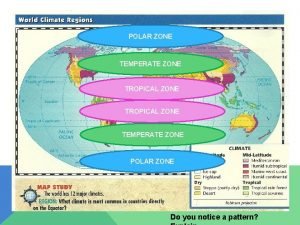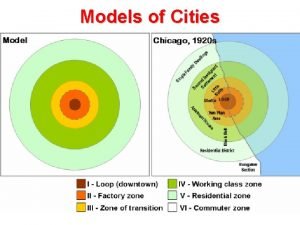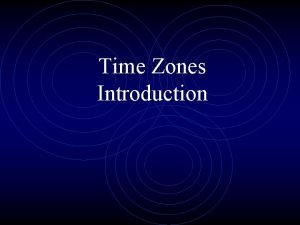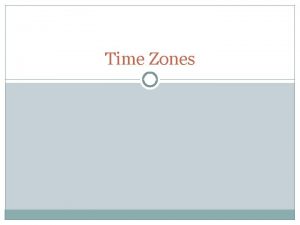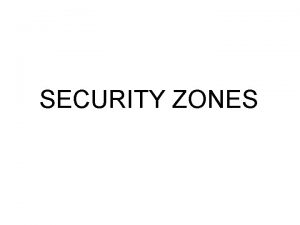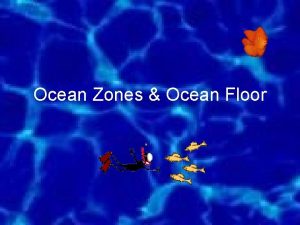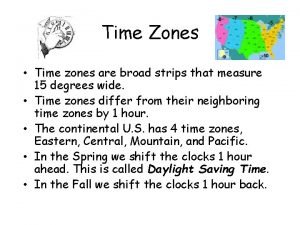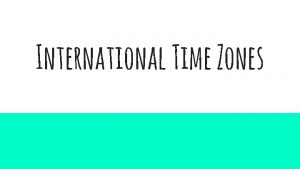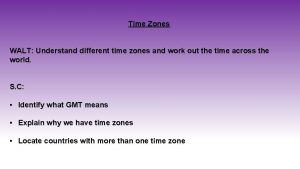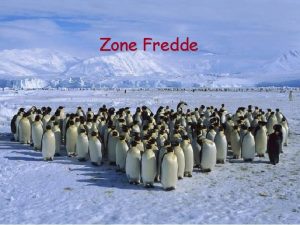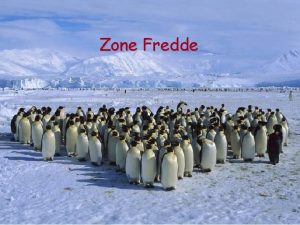Time Zones What is a Time Zone A

















- Slides: 17

Time Zones

What is a Time Zone? • A time zone is a region that has a standard time throughout it • There are 24 times zones throughout the world

Why do We Need Standard Time? • Before the late 1800 s, towns and cities would set their own times based on the sun • Due to the Earth’s rotation, each location’s time was different

Why do We Need Standard Time? • When railroads and telecommunications began to improve, it became difficult for each location to have its own time Table showing different times across the U. S. in 1857

Time Zones • In 1884, the international standard time system was established • The prime meridian was also established passing through Greenwich, England at 0° longitude

Time Zones • By the year 1900, almost everywhere on Earth used some form of standard time

Time Zones • Since there are 360° of longitude around the Earth and 24 time zones, each time zone is approximately 15° of longitude wide

Time Zones • The prime meridian is at 0° longitude • The international date line, where new days begin, is at 180° longitude

Time Zones • Time zone boundaries are irregular primarily due to political reasons – often it is helpful for a country to be completely within one time zone

Time Zones • Some countries are so large that they span multiple time zones • Notable examples include: – The United States (6) – Russia (11) – Brazil (3) Russia’s different time zones

Time Zones • Other large countries use single time zones that are larger than 15° of longitude • Notable examples include: – China – India

Time Zones • Many countries use daylight savings time (DST) during part of the year • Typically during DST, clocks are advanced one hour forward in the spring and adjusted back one hour in the fall Blue = currently uses DST, orange = once used DST but not currently, red = has not used DST

Time Zones • There are six time zones in the United States • Four time zones are in the continental United States: – Eastern – Central – Mountain – Pacific • The other two time zones are: – Alaska time – Hawaii time

Determining Times • If you know your local time, you can determine what time it is across the world

Determining Times • As you move east, add one hour to your time for each time zone you move through, for example: 3 pm 4 pm 5 pm 6 pm

Determining Times • Conversely, as you move west, subtract one hour for each time zone, for example: 10 am 11 am 12 pm 1 pm

Practice Questions
 Temperate regions
Temperate regions Intertidal zone neritic zone and oceanic zone
Intertidal zone neritic zone and oceanic zone Source zone transition zone and floodplain zone
Source zone transition zone and floodplain zone Youtube.com
Youtube.com How do littoral zones differ from riparian zones?
How do littoral zones differ from riparian zones? Stretched nostrils
Stretched nostrils Respiratory zone and conducting zone
Respiratory zone and conducting zone Zone froide zone chaude magasin
Zone froide zone chaude magasin Water table chart
Water table chart Underground water table
Underground water table Climate latitude
Climate latitude Photic zone and aphotic zone venn diagram
Photic zone and aphotic zone venn diagram Minute ventilation normal
Minute ventilation normal Zone 1 and zone 2
Zone 1 and zone 2 Burgess and hoyt model
Burgess and hoyt model Geographic terms jeopardy
Geographic terms jeopardy What geographical feature usually distinguishes time zones?
What geographical feature usually distinguishes time zones? Solar time
Solar time
